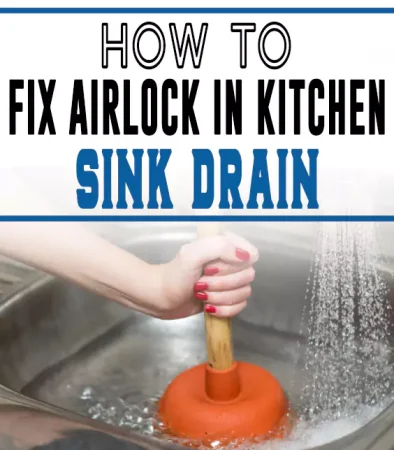Picture this: You’re in the midst of rinsing dishes when the water in your kitchen sink starts rising stubbornly. You attempt to drain it, but nothing happens. It’s an annoying situation that can quickly disrupt your kitchen routine. The culprit? An airlock in your kitchen sink drain.

Image: allareportable.com
Don’t fret! An airlock is a common plumbing issue that can be easily resolved with the right techniques. In this blog post, we’ll guide you through the steps to diagnose and fix airlocks in your kitchen sink drain effectively. So, grab your plunger and get ready to restore the smooth flow of water in your sink.
What is an Airlock in a Kitchen Sink Drain?
An airlock occurs when air gets trapped in your drainpipe, creating a vacuum that prevents water from draining properly. This can be caused by a variety of factors, including a clogged drain, a faulty P-trap, or even a dry sink trap.
When an airlock forms, the water in your sink will rise and gurgling noises may be heard as air tries to escape. To confirm an airlock, try filling your sink with water and listening for these sounds. Additionally, check for foul odors that may indicate a clogged drain.
Expert Techniques to Fix the Airlock
- Pouring Boiling Water: Pour a pot of boiling water down the drain. The hot water will help dissolve any clogs or debris that may be causing the airlock.
- Using a Plunger: Place a plunger over the drain and fill the sink with enough water to cover the plunger. Plunge vigorously to create a suction that can dislodge the airlock.
- Checking the P-trap: The P-trap is a U-shaped pipe located under the sink. If the P-trap becomes clogged, it can create an airlock. Remove the P-trap, clean it thoroughly, and reinstall it.
- Pouring Baking Soda and Vinegar: Pour 1/2 cup of baking soda down the drain, followed by 1/2 cup of white vinegar. Allow the mixture to sit for 15 minutes. The reaction between the baking soda and vinegar will create bubbles that can help dislodge the airlock.
- Calling a Professional Plumber: If none of these techniques work, it’s best to call a professional plumber. They can diagnose and fix the airlock using specialized tools and techniques.
Prevention Tips for Future Airlocks
Once you’ve fixed the airlock in your kitchen sink drain, there are some simple steps you can take to prevent future occurrences.
- Regularly Clean Your Drains: Pour a cup of baking soda down your drains once a month to prevent clogs.
- Avoid Pouring Grease Down the Drain: Grease can solidify in your drainpipes, leading to blockages.
- Trim Excess Fruit and Vegetables: Chop fruits and vegetables into smaller pieces before disposing of them in the garbage disposal to prevent them from clogging the drain.
- Use a Drain Strainer: Install a drain strainer to catch food particles and debris before they enter the drain.
- Keep the Sink Trap Full: Pour a cup of water down the drain occasionally to keep the trap full and prevent air from entering the drainpipe.

Image: faucetexpertise.com
Frequently Asked Questions
Q: Is it necessary to use a chemical drain cleaner to fix an airlock?
A: No, chemical drain cleaners are not recommended. They contain harsh chemicals that can damage your pipes and can be harmful to your health.
Q: How can I tell if my P-trap needs cleaning?
A: If there is a foul smell coming from your sink, or if water is draining slowly, this could indicate a need to clean your P-trap.
Q: How often should I inspect and clean my kitchen sink drain?
A: Inspect your kitchen sink drain every few months for signs of clogs or debris. If you notice any issues, clean the drain accordingly to prevent airlocks.
How To Fix Airlock In Kitchen Sink Drain
Conclusion
Fixing an airlock in your kitchen sink drain is a simple task that can be completed with basic tools and techniques. By following the steps outlined in this guide, pouring boiling water, using a plunger, checking the P-trap, or trying baking soda and vinegar, you can effectively restore the proper flow of water in your sink. Remember to prevent future airlocks by practicing these helpful tips and ensuring that your drains are regularly cleaned and maintained. If you encounter any difficulties, don’t hesitate to consult a professional plumber for assistance.
Do you have any tips or tricks for fixing airlocks in kitchen sink drains? Share them with us in the comments below.